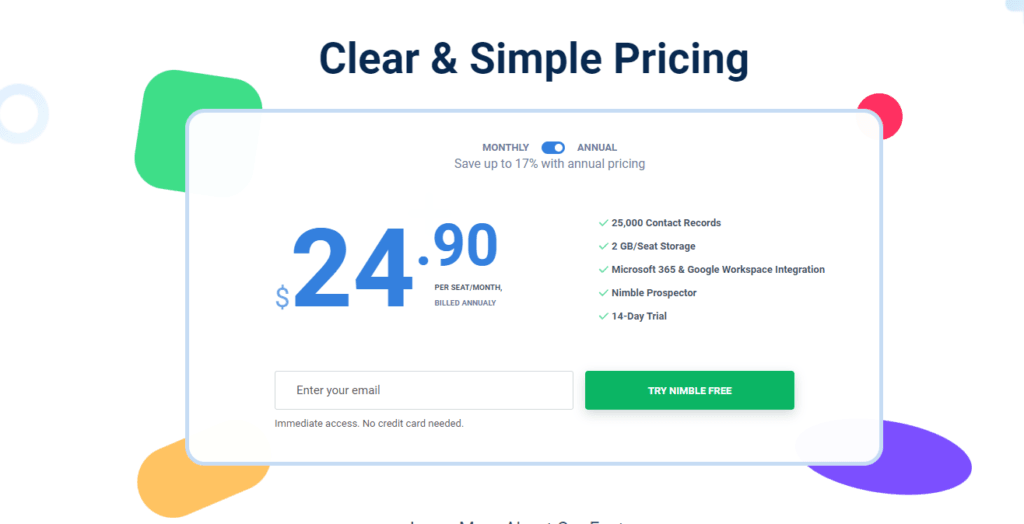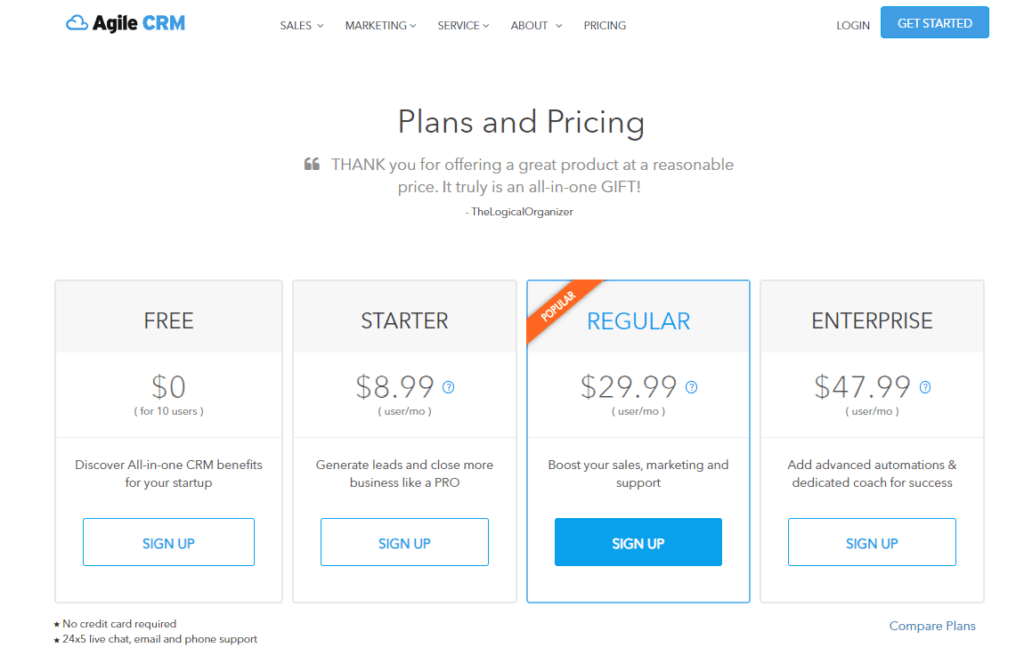In today’s digital age, finding the perfect CRM tool isn’t just an option; it’s a necessity for businesses aiming to thrive. Amidst a sea of choices, Nimble and Agile CRM stand out, promising to streamline customer interactions, enhance sales processes, and boost productivity. But which one is the beacon for your business in the vast CRM ocean? As we navigate through the features, integrations, and usability of Nimble and Agile CRM, let’s uncover which tool might be the best fit for you.
| Nimble | Agile CRM |
|---|---|
 |  |
| G2 Score -4.4 out of 5 | G2 Score -4.0 out of 5 |
| TrustRadius Score -7.4 out of 10 | TrustRadius Score -7.5 out of 10 |
Ease of Use and User Interface
In the bustling world of customer relationship management, where the complexity of managing numerous interactions meets the demand for simplicity, the ease of use and the design of the user interface (UI) are paramount. Let’s compare how Nimble and Agile CRM measure up in offering a user-friendly experience that can make or break your team’s productivity and adoption rates.
Nimble’s Simplistic Elegance
Nimble prides itself on its clean, intuitive interface designed for ease of navigation and simplicity. Recognized for seamlessly integrating social media insights into the CRM, Nimble ensures that enriching customer profiles and engaging with clients is a breeze. The platform’s dashboard is a testament to its user-centered design, offering a straightforward overview of tasks, calendar events, and opportunities without overwhelming users with excessive data.
The beauty of Nimble lies in its ability to provide a comprehensive view of your contacts and communications without complicating the user experience. Its emphasis on social interactions and the ease with which users can add contacts, update records, and track engagements directly from their inbox or social platforms highlight Nimble’s commitment to a frictionless CRM experience.
Agile CRM’s All-in-One Approach
Agile CRM, on the other hand, takes a robust approach by offering an all-in-one solution that encompasses sales, marketing, and service automation. While this integrated approach brings a wealth of features to the table, it also introduces a learning curve for users to navigate through its comprehensive suite. Agile CRM’s UI is designed to accommodate a wide array of functionalities, from email campaigns and appointment scheduling to project management and customer support.
Despite its broad feature set, Agile CRM strives to maintain a user-friendly interface, employing a dashboard that can be customized to display the most relevant information for each user. Its visual campaign builder is a highlight, providing a drag-and-drop interface that simplifies complex marketing automation tasks. However, mastering Agile CRM’s full potential may require a deeper dive into its features compared to simpler platforms.
Pricing and Scalability
When choosing a CRM, understanding the pricing structure and how the platform can scale with your business is crucial. Below, we break down the pricing for Nimble and Agile CRM to see how each caters to different business sizes and needs.
Nimble’s Pricing Model

Nimble offers a straightforward pricing model, designed to simplify the decision-making process for small to medium-sized businesses. The simplicity of a single pricing plan aims to make budgeting easier for businesses by providing clear expectations of monthly or annual costs.
Nimble’s primary plan includes access to a comprehensive set of features including contact management, sales and marketing automation, and social media integration. This plan is priced per user, making it scalable for teams of various sizes. The cost typically ranges around $25 per user per month when billed annually, or a slightly higher rate if billed on a monthly basis.
Nimble’s model is particularly suited for SMBs that anticipate gradual growth. Adding new users is a straightforward process, ensuring that businesses can scale their CRM usage as they expand. The pricing structure’s simplicity makes it easy for businesses to project costs as their team grows.
Agile CRM’s Pricing Structure

Agile CRM adopts a tiered pricing strategy, offering multiple plans to accommodate the varying needs of businesses at different growth stages. This model allows companies to start with basic functionalities and scale up to more advanced features as needed. Aimed at small businesses and startups, this plan supports a limited number of users and offers basic CRM functionalities. Designed for small to growing businesses, this plan includes additional CRM features and marketing automation capabilities.
Catering to growing SMEs, this plan offers more advanced features, including custom deal milestones and more extensive marketing automation tools. The most comprehensive plan, suited for large businesses or those with complex CRM needs, includes all features offered by Agile CRM.
Each higher tier increases in price, adding more features, users, and capacity for customer records and emails. Pricing ranges from free for the basic tier to a higher cost per user per month for the enterprise level, making it crucial for businesses to assess which plan best fits their current and future needs.
Integration Capabilities
The ability to integrate with other software solutions—from email marketing platforms and social networks to accounting software and customer support tools—expands the functionality of a CRM, enabling businesses to centralize their operations and data management.
Nimble’s Integration Ecosystem
Nimble stands out for its strong social media integration, automatically enriching contact profiles with valuable insights from social networks. This feature is particularly useful for businesses that leverage social selling and wish to maintain a holistic view of their customer interactions across various platforms.
Nimble seamlessly integrates with a wide array of essential business tools, including but not limited to Google Workspace for productivity, Mailchimp for email marketing, and HubSpot for inbound marketing activities. Its compatibility with these tools ensures that businesses can maintain their productivity workflows efficiently. Additionally, Nimble utilizes Zapier, a tool that connects Nimble with thousands of other apps, even if direct integration isn’t natively supported. This extends Nimble’s utility beyond its immediate ecosystem, enabling businesses to craft a highly customized tech stack that meets their unique needs.
The emphasis on social media and the ease of integrating with productivity and marketing tools make Nimble an excellent option for small to medium-sized businesses looking for a CRM that enhances their customer relationship management without the need for complex technical setups.
Agile CRM’s Comprehensive Integration Landscape
Agile CRM provides a broad spectrum of integration options, designed to cater to a more diverse range of business processes. This includes not only basic CRM functionalities but also advanced sales, marketing, and service automation tools, making Agile CRM a versatile platform for businesses looking to centralize their operations.
Agile CRM’s integration capabilities extend across various categories, including email platforms like Gmail and Outlook for seamless communication, marketing tools such as Twilio for SMS marketing, and Stripe for payment processing. This extensive range of integrations supports Agile CRM’s all-in-one approach, allowing businesses to automate and manage their sales, marketing, and customer service processes within a single platform. The platform also integrates with Zapier, offering connections to additional apps and services that may not be directly supported, thus enhancing its flexibility.
Agile CRM’s wide array of integrations is particularly beneficial for businesses that require a comprehensive solution capable of automating complex workflows across sales, marketing, and customer support. Its ability to connect with a variety of tools and services ensures that businesses can tailor the CRM to their specific operational requirements.

Related: Check out our free SEO suite

Analytics
Analytics and reporting functionalities within a CRM allow businesses to track performance, understand customer behaviors, and identify opportunities for improvement. Let’s examine how Nimble and Agile CRM stack up in providing businesses with the analytical tools they need.
Nimble’s Analytical Offerings
Nimble focuses on providing straightforward analytics designed to offer clear insights into customer engagement, sales pipeline, and marketing effectiveness. Its analytics suite is built to cater to the needs of small to medium-sized businesses looking for actionable insights without the complexity often associated with advanced analytical tools.
Nimble’s dashboard presents a concise overview of sales and marketing metrics, enabling businesses to quickly gauge their performance. Features like contact engagement scoring and deal tracking help sales teams prioritize efforts and tailor their strategies based on customer interaction data. For marketing, Nimble integrates with third-party tools like Mailchimp, allowing for detailed email campaign analytics within the platform. While Nimble’s native analytical capabilities might not delve as deep as those of more specialized platforms, they provide sufficient insights for businesses to make informed decisions and strategies.
Agile CRM’s Comprehensive Analytics
Agile CRM offers a more extensive suite of analytics and reporting tools, catering to businesses that require detailed insights across sales, marketing, and customer service operations. Its ability to generate a wide range of reports and track numerous metrics makes Agile CRM a powerful tool for businesses aiming to leverage data for strategic advantage.
Agile CRM’s analytics cover everything from web visitor analytics and campaign performance to sales forecasting and service ticket reporting. The platform’s visual campaign builder includes detailed analytics on campaign effectiveness, allowing users to fine-tune their marketing strategies for optimal results. Sales teams can benefit from Agile CRM’s advanced reporting on sales milestones, deal pipelines, and performance metrics, facilitating targeted sales strategies and forecasting. Additionally, Agile CRM provides customizable reports, enabling businesses to tailor their analytics to fit specific needs and goals.
Conclusion
The journey through the functionalities, pricing, integration capabilities, and analytics of Nimble and Agile CRM has provided a landscape view of what each platform offers. Each CRM system comes with its strengths, designed to meet the demands of various business models, operational scales, and strategic objectives. Nimble has positioned itself as a highly user-friendly and efficient platform, emphasizing simplicity, social media integration, and seamless operation. It is tailored for small to medium-sized businesses that prioritize ease of use and effective customer engagement over complex functionalities.
On the other hand, Agile CRM offers a more feature-rich experience, with advanced capabilities in marketing automation, comprehensive analytics, and a wide range of integrations. Its tiered pricing model provides scalability, catering to businesses at different growth stages. Agile CRM is suitable for companies that require a robust CRM solution to manage complex sales, marketing, and customer service processes within a unified platform.
READ NEXT:





















